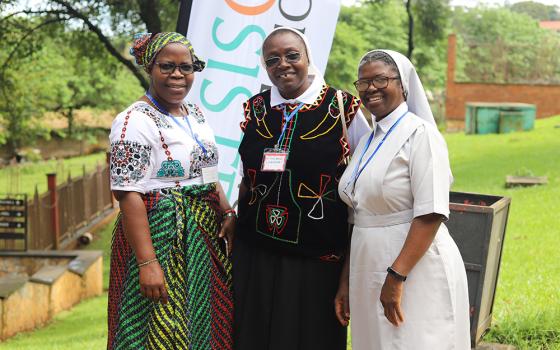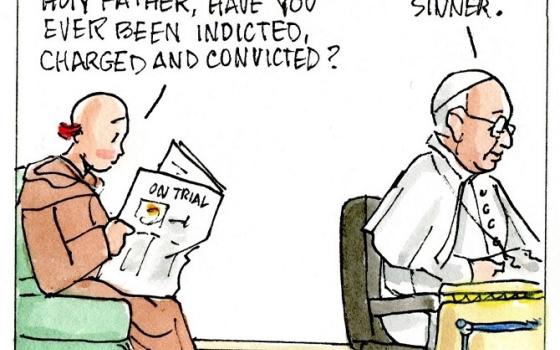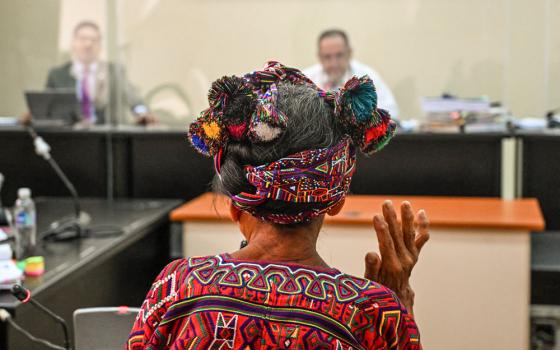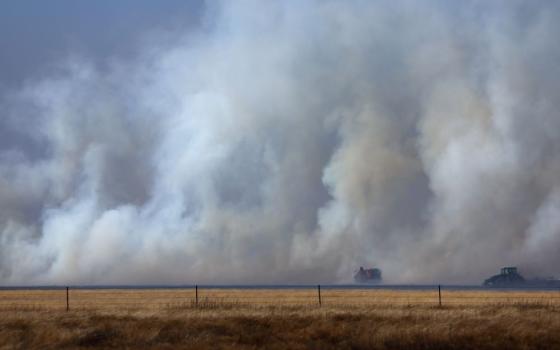Marco Politi, to be sure, has a point of view. A veteran Italian journalist and commentator, mostly for the leftist La Repubblica, Politi's sympathies clearly run to the Catholic church's progressive wing. It thus may be tempting to see his critical new book on Benedict XVI, titled Joseph Ratzinger: Crisis of a Papacy, as the predictable grumbling of someone who just doesn't like what this pope stands for.
However understandable, that would be a mistake.
 I've known Politi for two decades, covering Vatican happenings with him and reading his stuff. Whatever one makes of his big-picture perspective, he's an astute observer, and there's always something to learn from what he has to say. (Proof that Politi is taken seriously in the Vatican is that Gian Maria Vian, editor of L'Osservatore Romano, was among the panelists at a Nov. 16 presentation of the book in Rome -- even though Vian said he came as a "devil's advocate" to argue that the book "shouldn't be canonized.")
I've known Politi for two decades, covering Vatican happenings with him and reading his stuff. Whatever one makes of his big-picture perspective, he's an astute observer, and there's always something to learn from what he has to say. (Proof that Politi is taken seriously in the Vatican is that Gian Maria Vian, editor of L'Osservatore Romano, was among the panelists at a Nov. 16 presentation of the book in Rome -- even though Vian said he came as a "devil's advocate" to argue that the book "shouldn't be canonized.")
Politi's core thesis is expressed in the provocative assertion that Benedict XVI is a "part-time pope."
As Politi sees it, Benedict dips in to running the church or acting as a global leader only when circumstances require it. His passion, however, is focused on his private theological studies and his own writings.
"Joseph Ratzinger has revealed himself to be a fragile leader," Politi writes, "uncomfortable in the art of government, hesitant to confront the internal problems of the church, more sensitive to theology than geopolitics."
The result, according to Politi, is a "gap in governance".
Benedict, in Politi's eyes, has not articulated a clear vision for confronting the church's big-ticket challenges, such as the global priest shortage. So far, Politi asserts, the two most consequential reforms on Benedict's watch -- tighter norms on sex abuse and more transparent money management -- were "imposed by circumstances."
Perhaps most damaging, according to Politi, is that the geopolitical relevance of the Catholic church accumulated under John Paul II is in free-fall. For instance, he asserts that Benedict has had little incisive to say about the Arab Spring, arguably the most significant mutation of the global order since the collapse of Communism.
In the Vatican, Politi reports, there's a sense of frustration. He quotes a Vatican official who says that in the absence of monthly meetings of department heads, "everyone is running their own shop, without any reference to a common direction or a shared vision."
As a result, Politi writes, even after six and a half years of Benedict's papacy, "A priest, a journalist or a church historian can still be approached during a conversation and confronted with an apparently bizarre question: 'What's this pope like?'"
t
To be sure, there's much in Politi's analysis open to debate.
For one thing, he provides a speculative reconstruction of the conclave of April 2005, putting a great deal of weight on a supposed cabal of pro-Ratzinger conservatives in the Roman curia, led by several Spanish-speakers. He repeats a dubious thesis he has floated before, which is that rule changes introduced by John Paul II, providing for election by simple majority rather than the traditional two-thirds in the event of a lengthy deadlock, forced the opposition to Ratzinger to capitulate, because they knew a 50-percent-plus-one bloc could hold out for several days and get their man.
Politi concludes that this pro-Ratzinger lobby had no long-term project for the future of the church, but was instead driven by a "reflex of fear" and an "obsessive need for identity."
Surveying the almost seven years of Benedict's reign, Politi faults the pope for not moving forward on the reform program of many progressives, including decentralization of power away from Rome. He also laments Benedict's decisions to grant wider permission for the old Latin Mass, and to lift the excommunications of four traditionalist bishops.
Needless to say, all that will draw sharp rebuttals in some quarters.
Yet in his claim of a "gap in governance," Politi is on reasonably objective ground. Scores of other observers have reached the same conclusion, including his Italian colleagues Andrea Tornielli and Paolo Rodari in the 2010 book Attacco a Ratzinger -- both of whom are inclined to much greater sympathy for Benedict's theology and politics.
The governance gap occasionally erupts in in the form of a public meltdown, such as the cause célèbre over a Holocaust-denying bishop, or explosive public commentary from some Vatican officials on the sex abuse crisis. More routinely, the gap registers in a quiet lack of direction and disengagement from the issues of the day. Declining media interest in the Vatican and the papacy over the last six years reflects this reality; in effect, the Vatican has become largely a Catholic insider story, a stark contrast with the John Paul years.
Another veteran Italian writer, Luigi Accattoli, recently devoted a 2,000-word blog to responding to Politi's book. In defense of the pope, Accattoli insists that Politi ignores the wisdom of Benedict's emphasis on personal conversion rather than structural reform and undervalues the steps he's taken to combat sexual abuse or to reach out to secular culture.
Yet when Politi writes that the "greatest sin of this pontificate is that in the Vatican, they talk very little about the strategic choices that need to be made," Accattoli adds an amen: "I couldn't have said it better myself."
The key lies in grasping that Benedict XVI sees himself as a teaching pope, not (at least, not primarily) a governing pope.
Benedict believes deeply in the power of ideas, and Politi provides a terrific anecdote illustrating the point. Shortly after Benedict's election, Politi reports, the Vatican spokesperson asked the new pontiff how we wanted his official portrait to look. When Benedict expressed disinterest, the spokesperson reminded the pope that "a picture is worth a thousand words."
Benedict offered this lapidary response: "Yes, but a concept is worth a thousand pictures."
As Politi notes, this conviction runs through Benedict's papacy, even down to his personal style. When Benedict reads his speeches, he rarely makes eye contact and rarely varies his tempo or intonation -- apparently convinced that good argument requires no artifice.
It may well be that 200 years from now, Benedict XVI will be remembered as one of the great teaching popes. His three encyclicals have played to positive reviews, and his books on Jesus have drawn interest well outside the church. His speeches on his foreign trips generally come off as thoughtful and constructive, perhaps especially what is now a four-volume reflection on faith, reason and democracy, formed by addresses in Regensburg in 2006, the Collège des Bernardins in Paris in 2008, Westminster Hall in 2010 and the Bundestag in Germany this year.
All this, however, comes at a price.
By choice and by temperament, Benedict is disinclined to wield the tools of statecraft to try to shape events in the here-and-now, either in the church or on the global stage. That's a prescription for a papacy, and a Vatican, a bit more withdrawn, less politically engaged, and less "relevant" by the usual standards -- not to mention occasionally disorganized and caught off-guard by unforeseen developments.
Depending on who's doing the looking, this preference for reflection over realpolitik is either Benedict's charm or his Achilles' heel. But, as the saying goes, it is what it is.
* * *
Politi admired John Paul II for the way he was able to exercise the "soft power" of the papacy to shape the history of his time, from the collapse of Communism to the emergence of the developing world. One of the most insightful passages of Crisis of a Papacy comes when Politi identifies the four great roles the papacy plays on the global stage, well outside the boundaries of the church.
At the end of John Paul's reign, Politi writes, the papacy was widely understood to play these unique roles:
- "Respected interlocutor of the religions of the world, beginning with the other two great monotheisms: Judaism and Islam."
- "Spokesperson for human rights, beyond geographic, political, religious and cultural frontiers."
- A bully pulpit "capable of authoritatively addressing questions of war and peace," such as the war in Iraq.
- A religious authority capable of critically challenging the "errors and horrors" of distorted forms of religion, such as violence, intolerance, fundamentalism, and excessive entanglement with power.
"This is the legacy, beyond the coherence of its own creed and the witness to its own values, upon which the greater or lesser presence and influence of the Catholic church in the planetary arena depends," Politi writes.
One could certainly argue that Politi undervalues Benedict's contributions on those fronts. For instance, the four papal speeches listed above offered compelling challenges to the "errors and horrors" of faith detached from reason. Benedict's vision of an "alliance of civilizations" between Christianity and Islam has laid a foundation for cooperation on a wide range of fronts, and the Religion Newswriters Association recently considered naming the pope "Person of the Year" for his efforts to improve relations with Judaism.
One might also argue that Politi left at least one key role off his list: The papacy as spokesperson for religion's right of citizenship in a highly secular age, insisting that religious institutions and individuals can be constructive partners in secular societies while still remaining true to themselves. That's the essence of Benedict's vision of Christianity as a "creative minority."
Nonetheless, Politi is probably right that the four roles he identified represent key elements of John Paul's legacy which, to greater or lesser extents, have been attenuated during Benedict's teaching papacy. How to revive them, and who's best equipped to do so, may well be among the questions facing the next conclave.
* * *
Like any book by a good reporter, Crisis of a Papacy offers several nuggets of insight and factoids along the way. The following are two such nuggets from Politi's book worth pulling out.
One concerns the role of women. Politi notes that in a meeting with the clergy of Rome in 2006, Benedict said, "It is right to ask whether in ministerial service ... it might be possible to make more room, to give more offices of responsibility to women."
Yet five years after those remarks, Politi observes, the situation in the Vatican -- which is, after all, the ministerial environment over which a pope has the most direct control -- is largely unchanged. Here's what he reports:
- There are only two women at the level of "superiors," meaning decision-making roles: Salesian Sr. Enrica Rosanna, under-secretary of the Congregation for Religious, and Flaminia Giovanelli, under-secretary of the Council for Justice and Peace, a lay member of Focolare.
- In the first section of the Secretariat of State, which handles internal church business, no woman holds the role of a "head of office," and there's just one sister working at the lower administrative level. In the second section, responsible for foreign relations, it's the same -- just one woman at the basic administrative level.
- In the Congregation for the Doctrine of the Faith, there's no female theologian among the consulters, and there's no woman on the commission responsible for matrimonial cases. On the International Theological Commission, which advises the congregation on doctrinal issues, there are two women among the 29 members.
Another nugget comes on the priest shortage.
Politi notes that some in the Vatican have taken consolation in a slight uptick in the global number of priests from 2004 to 2009. Worldwide, the number of priests grew from 405,891 to 410,593 over that period, plus an additional 15,000 seminarians. As Politi notes, that growth came in Africa and Asia; the number of priests in North America declined by 4,000, and the drop-off in Europe was 8,000.
Yet as Politi also observes, the world's total Catholic population also grew by 15 million in one year alone, 2008-2009, so the numerical disproportion between priests and people has expanded dramatically.
What this points to is an underappreciated fact of Catholic life: Rapid growth in the Catholic population in a given part of the world usually makes priest shortages worse, not better, because the church can baptize people more rapidly than it can ordain them.
The paradox, as Politi notes, is that the church in the West is becoming increasingly dependent on priests from parts of the world where shortages are actually far more acute. He cites statistics from 2003 that in four Italian regions (Abruzzo, Molise, Toscana and Umbria), foreign priests represented more than 10 percent of all diocesan clergy. In Lazio -- the region that includes Rome -- fully 20 percent of all priests involved in direct pastoral ministry come from abroad.
At some point, the question has to be asked: Does a situation in which two-thirds of the Catholic people live in the southern hemisphere, but two-thirds of priests in the northern hemisphere, make any sense? That, perhaps, is another strategic choice the Vatican eventually will have to confront.
[John L. Allen Jr. is NCR's senior correspondent. His email address is jallen@ncronline.org.]




